PepsiCo's Strategic Human Resource Management: Leave Loudly Strategy
VerifiedAdded on 2021/06/17
|11
|2961
|38
Essay
AI Summary
This essay provides a comprehensive analysis of PepsiCo's strategic human resource management, with a specific focus on the 'Leave Loudly' policy implemented in Australia and New Zealand. The essay begins with an introduction to strategic HRM, followed by an overview of PepsiCo's strategic HR priorities, including talent management, diversity, and workforce development. The rationale behind the 'Leave Loudly' strategy, which encourages senior employees to leave work early to improve work-life balance, is discussed. The essay examines how this policy aligns with PepsiCo's broader HR practices, such as equity and diversity, social responsibility, and workforce planning. Furthermore, it explores how the CEO's personal life influenced the implementation of the 'Leave Loudly' strategy and how this approach can improve workplace morale and productivity. The conclusion summarizes the key findings and emphasizes the importance of work-life balance in fostering employee satisfaction and engagement.
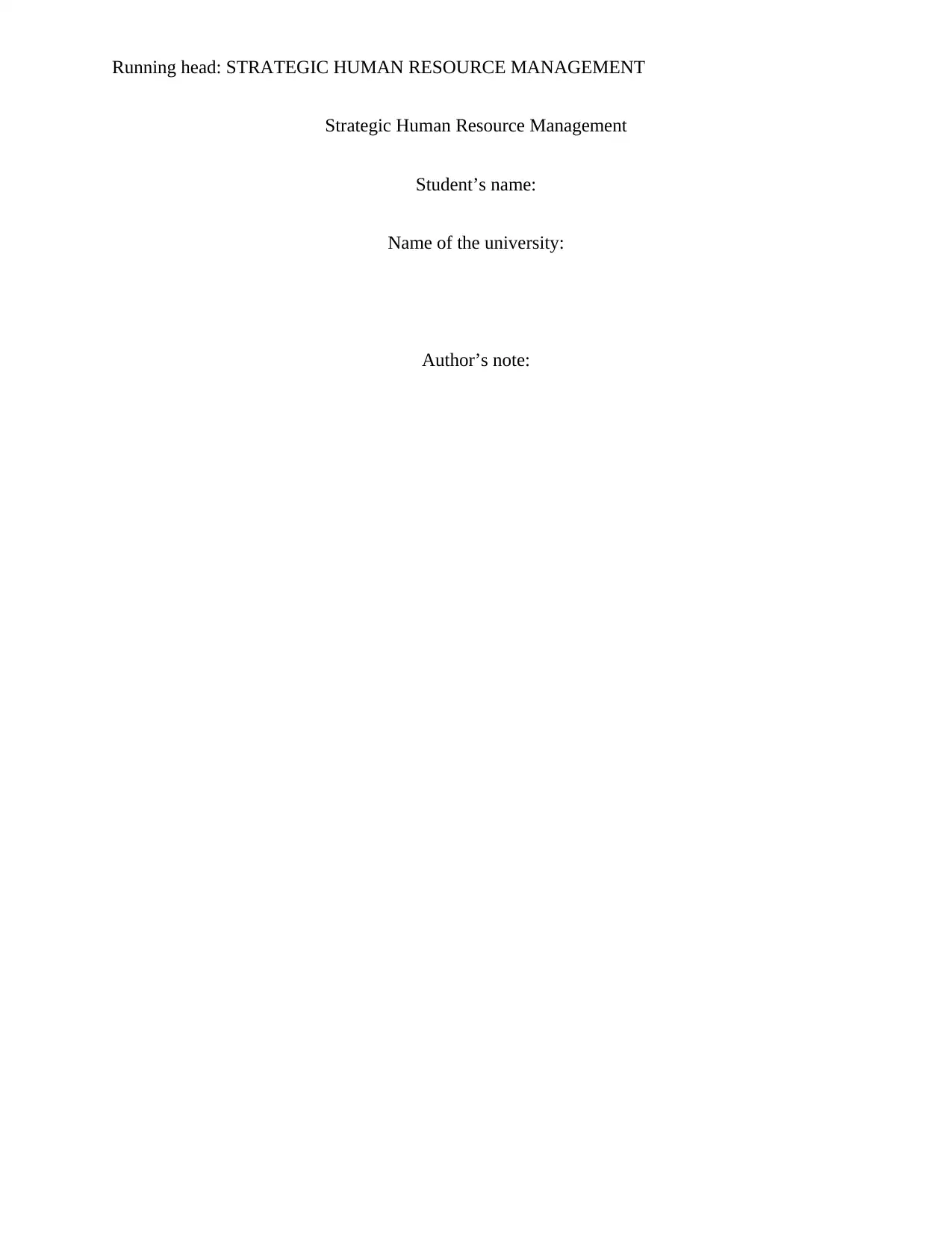
Running head: STRATEGIC HUMAN RESOURCE MANAGEMENT
Strategic Human Resource Management
Student’s name:
Name of the university:
Author’s note:
Strategic Human Resource Management
Student’s name:
Name of the university:
Author’s note:
Paraphrase This Document
Need a fresh take? Get an instant paraphrase of this document with our AI Paraphraser
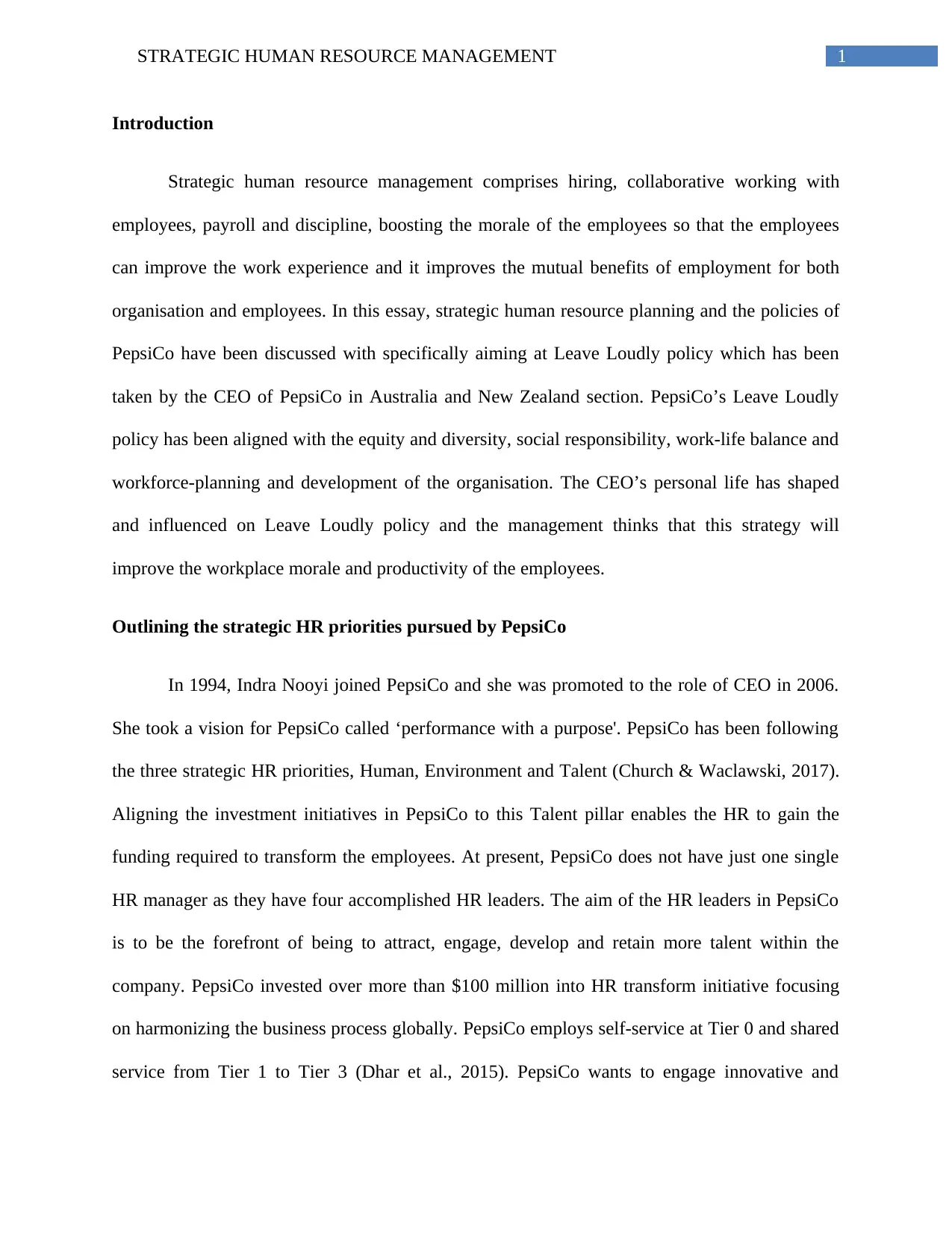
1STRATEGIC HUMAN RESOURCE MANAGEMENT
Introduction
Strategic human resource management comprises hiring, collaborative working with
employees, payroll and discipline, boosting the morale of the employees so that the employees
can improve the work experience and it improves the mutual benefits of employment for both
organisation and employees. In this essay, strategic human resource planning and the policies of
PepsiCo have been discussed with specifically aiming at Leave Loudly policy which has been
taken by the CEO of PepsiCo in Australia and New Zealand section. PepsiCo’s Leave Loudly
policy has been aligned with the equity and diversity, social responsibility, work-life balance and
workforce-planning and development of the organisation. The CEO’s personal life has shaped
and influenced on Leave Loudly policy and the management thinks that this strategy will
improve the workplace morale and productivity of the employees.
Outlining the strategic HR priorities pursued by PepsiCo
In 1994, Indra Nooyi joined PepsiCo and she was promoted to the role of CEO in 2006.
She took a vision for PepsiCo called ‘performance with a purpose'. PepsiCo has been following
the three strategic HR priorities, Human, Environment and Talent (Church & Waclawski, 2017).
Aligning the investment initiatives in PepsiCo to this Talent pillar enables the HR to gain the
funding required to transform the employees. At present, PepsiCo does not have just one single
HR manager as they have four accomplished HR leaders. The aim of the HR leaders in PepsiCo
is to be the forefront of being to attract, engage, develop and retain more talent within the
company. PepsiCo invested over more than $100 million into HR transform initiative focusing
on harmonizing the business process globally. PepsiCo employs self-service at Tier 0 and shared
service from Tier 1 to Tier 3 (Dhar et al., 2015). PepsiCo wants to engage innovative and
Introduction
Strategic human resource management comprises hiring, collaborative working with
employees, payroll and discipline, boosting the morale of the employees so that the employees
can improve the work experience and it improves the mutual benefits of employment for both
organisation and employees. In this essay, strategic human resource planning and the policies of
PepsiCo have been discussed with specifically aiming at Leave Loudly policy which has been
taken by the CEO of PepsiCo in Australia and New Zealand section. PepsiCo’s Leave Loudly
policy has been aligned with the equity and diversity, social responsibility, work-life balance and
workforce-planning and development of the organisation. The CEO’s personal life has shaped
and influenced on Leave Loudly policy and the management thinks that this strategy will
improve the workplace morale and productivity of the employees.
Outlining the strategic HR priorities pursued by PepsiCo
In 1994, Indra Nooyi joined PepsiCo and she was promoted to the role of CEO in 2006.
She took a vision for PepsiCo called ‘performance with a purpose'. PepsiCo has been following
the three strategic HR priorities, Human, Environment and Talent (Church & Waclawski, 2017).
Aligning the investment initiatives in PepsiCo to this Talent pillar enables the HR to gain the
funding required to transform the employees. At present, PepsiCo does not have just one single
HR manager as they have four accomplished HR leaders. The aim of the HR leaders in PepsiCo
is to be the forefront of being to attract, engage, develop and retain more talent within the
company. PepsiCo invested over more than $100 million into HR transform initiative focusing
on harmonizing the business process globally. PepsiCo employs self-service at Tier 0 and shared
service from Tier 1 to Tier 3 (Dhar et al., 2015). PepsiCo wants to engage innovative and
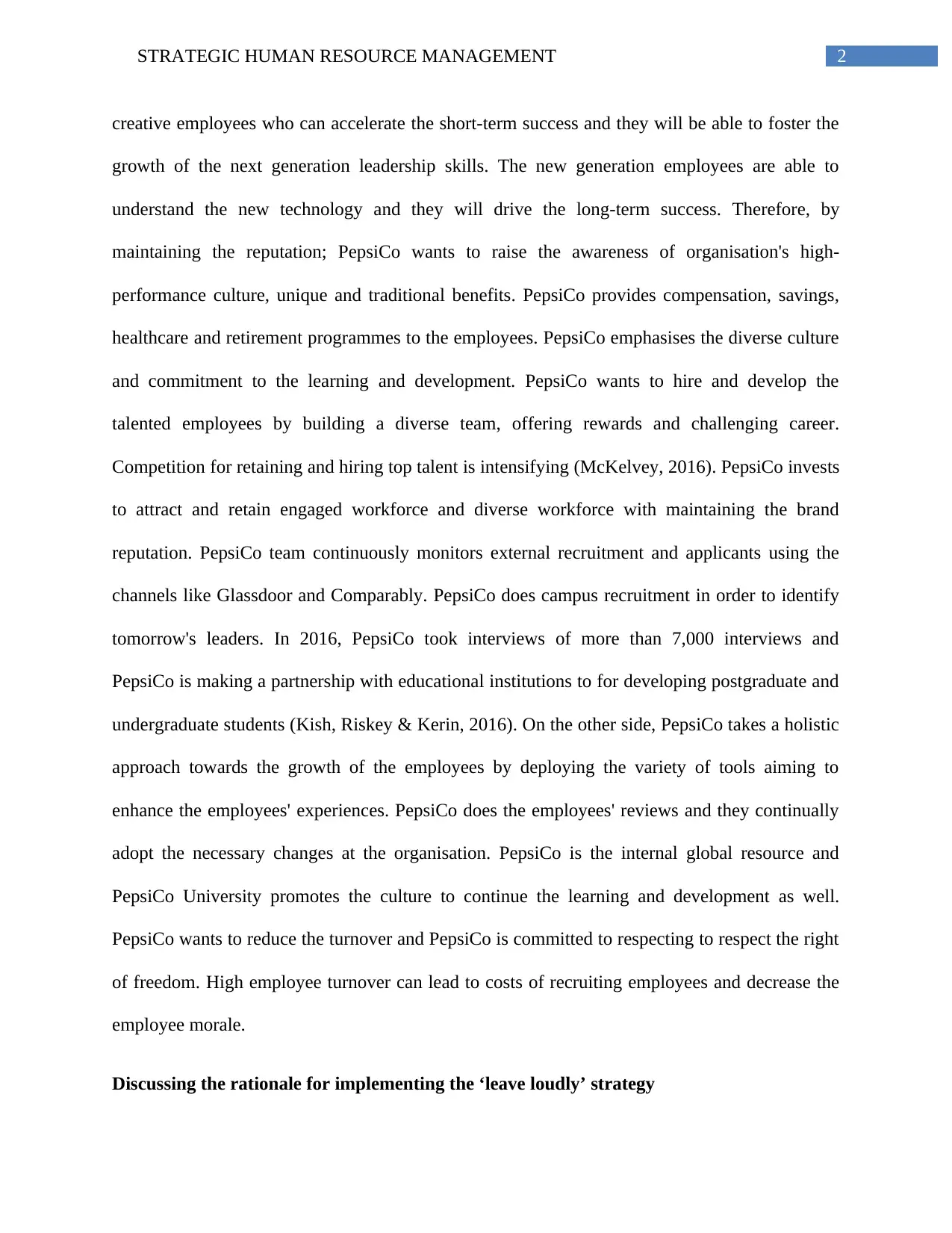
2STRATEGIC HUMAN RESOURCE MANAGEMENT
creative employees who can accelerate the short-term success and they will be able to foster the
growth of the next generation leadership skills. The new generation employees are able to
understand the new technology and they will drive the long-term success. Therefore, by
maintaining the reputation; PepsiCo wants to raise the awareness of organisation's high-
performance culture, unique and traditional benefits. PepsiCo provides compensation, savings,
healthcare and retirement programmes to the employees. PepsiCo emphasises the diverse culture
and commitment to the learning and development. PepsiCo wants to hire and develop the
talented employees by building a diverse team, offering rewards and challenging career.
Competition for retaining and hiring top talent is intensifying (McKelvey, 2016). PepsiCo invests
to attract and retain engaged workforce and diverse workforce with maintaining the brand
reputation. PepsiCo team continuously monitors external recruitment and applicants using the
channels like Glassdoor and Comparably. PepsiCo does campus recruitment in order to identify
tomorrow's leaders. In 2016, PepsiCo took interviews of more than 7,000 interviews and
PepsiCo is making a partnership with educational institutions to for developing postgraduate and
undergraduate students (Kish, Riskey & Kerin, 2016). On the other side, PepsiCo takes a holistic
approach towards the growth of the employees by deploying the variety of tools aiming to
enhance the employees' experiences. PepsiCo does the employees' reviews and they continually
adopt the necessary changes at the organisation. PepsiCo is the internal global resource and
PepsiCo University promotes the culture to continue the learning and development as well.
PepsiCo wants to reduce the turnover and PepsiCo is committed to respecting to respect the right
of freedom. High employee turnover can lead to costs of recruiting employees and decrease the
employee morale.
Discussing the rationale for implementing the ‘leave loudly’ strategy
creative employees who can accelerate the short-term success and they will be able to foster the
growth of the next generation leadership skills. The new generation employees are able to
understand the new technology and they will drive the long-term success. Therefore, by
maintaining the reputation; PepsiCo wants to raise the awareness of organisation's high-
performance culture, unique and traditional benefits. PepsiCo provides compensation, savings,
healthcare and retirement programmes to the employees. PepsiCo emphasises the diverse culture
and commitment to the learning and development. PepsiCo wants to hire and develop the
talented employees by building a diverse team, offering rewards and challenging career.
Competition for retaining and hiring top talent is intensifying (McKelvey, 2016). PepsiCo invests
to attract and retain engaged workforce and diverse workforce with maintaining the brand
reputation. PepsiCo team continuously monitors external recruitment and applicants using the
channels like Glassdoor and Comparably. PepsiCo does campus recruitment in order to identify
tomorrow's leaders. In 2016, PepsiCo took interviews of more than 7,000 interviews and
PepsiCo is making a partnership with educational institutions to for developing postgraduate and
undergraduate students (Kish, Riskey & Kerin, 2016). On the other side, PepsiCo takes a holistic
approach towards the growth of the employees by deploying the variety of tools aiming to
enhance the employees' experiences. PepsiCo does the employees' reviews and they continually
adopt the necessary changes at the organisation. PepsiCo is the internal global resource and
PepsiCo University promotes the culture to continue the learning and development as well.
PepsiCo wants to reduce the turnover and PepsiCo is committed to respecting to respect the right
of freedom. High employee turnover can lead to costs of recruiting employees and decrease the
employee morale.
Discussing the rationale for implementing the ‘leave loudly’ strategy
⊘ This is a preview!⊘
Do you want full access?
Subscribe today to unlock all pages.

Trusted by 1+ million students worldwide
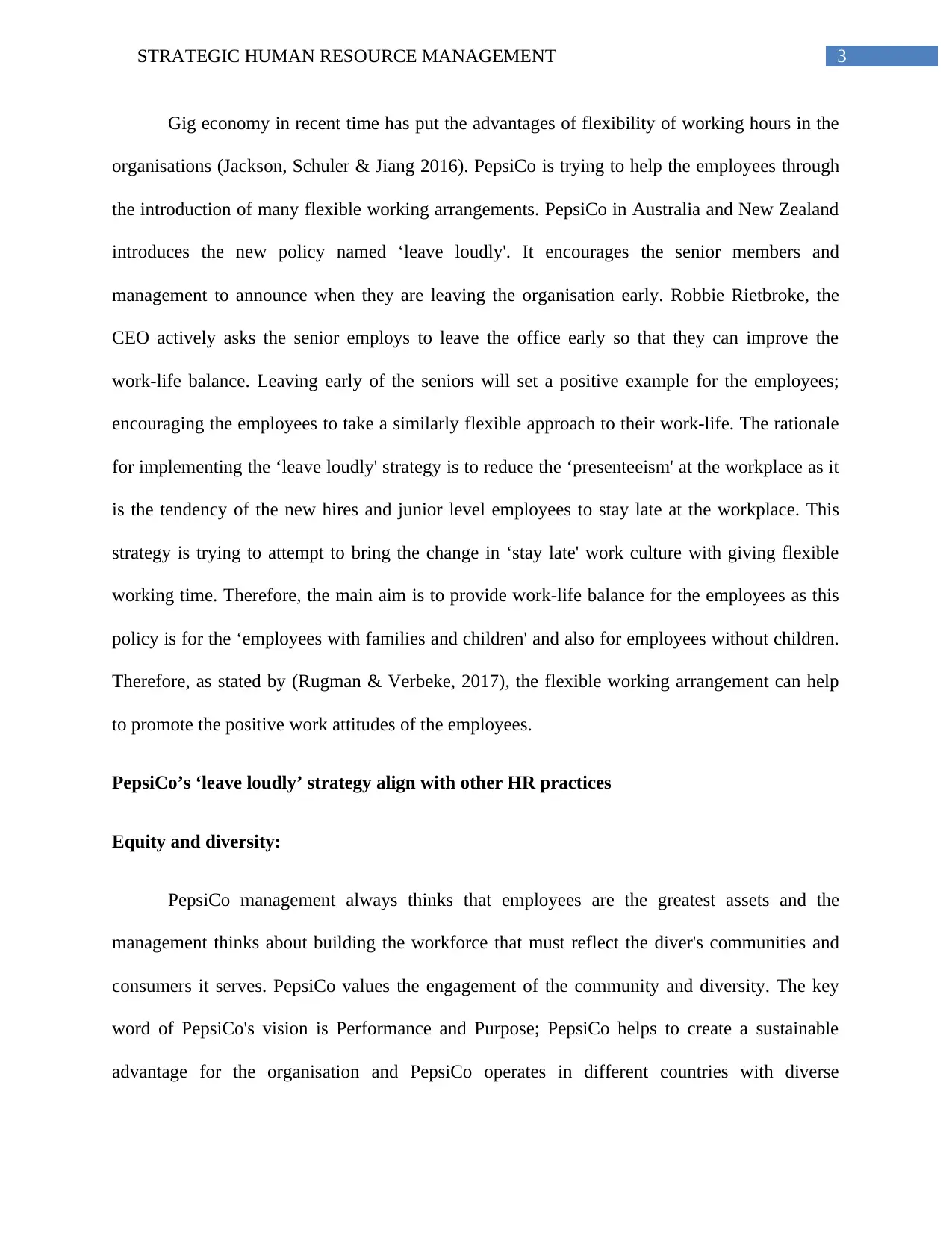
3STRATEGIC HUMAN RESOURCE MANAGEMENT
Gig economy in recent time has put the advantages of flexibility of working hours in the
organisations (Jackson, Schuler & Jiang 2016). PepsiCo is trying to help the employees through
the introduction of many flexible working arrangements. PepsiCo in Australia and New Zealand
introduces the new policy named ‘leave loudly'. It encourages the senior members and
management to announce when they are leaving the organisation early. Robbie Rietbroke, the
CEO actively asks the senior employs to leave the office early so that they can improve the
work-life balance. Leaving early of the seniors will set a positive example for the employees;
encouraging the employees to take a similarly flexible approach to their work-life. The rationale
for implementing the ‘leave loudly' strategy is to reduce the ‘presenteeism' at the workplace as it
is the tendency of the new hires and junior level employees to stay late at the workplace. This
strategy is trying to attempt to bring the change in ‘stay late' work culture with giving flexible
working time. Therefore, the main aim is to provide work-life balance for the employees as this
policy is for the ‘employees with families and children' and also for employees without children.
Therefore, as stated by (Rugman & Verbeke, 2017), the flexible working arrangement can help
to promote the positive work attitudes of the employees.
PepsiCo’s ‘leave loudly’ strategy align with other HR practices
Equity and diversity:
PepsiCo management always thinks that employees are the greatest assets and the
management thinks about building the workforce that must reflect the diver's communities and
consumers it serves. PepsiCo values the engagement of the community and diversity. The key
word of PepsiCo's vision is Performance and Purpose; PepsiCo helps to create a sustainable
advantage for the organisation and PepsiCo operates in different countries with diverse
Gig economy in recent time has put the advantages of flexibility of working hours in the
organisations (Jackson, Schuler & Jiang 2016). PepsiCo is trying to help the employees through
the introduction of many flexible working arrangements. PepsiCo in Australia and New Zealand
introduces the new policy named ‘leave loudly'. It encourages the senior members and
management to announce when they are leaving the organisation early. Robbie Rietbroke, the
CEO actively asks the senior employs to leave the office early so that they can improve the
work-life balance. Leaving early of the seniors will set a positive example for the employees;
encouraging the employees to take a similarly flexible approach to their work-life. The rationale
for implementing the ‘leave loudly' strategy is to reduce the ‘presenteeism' at the workplace as it
is the tendency of the new hires and junior level employees to stay late at the workplace. This
strategy is trying to attempt to bring the change in ‘stay late' work culture with giving flexible
working time. Therefore, the main aim is to provide work-life balance for the employees as this
policy is for the ‘employees with families and children' and also for employees without children.
Therefore, as stated by (Rugman & Verbeke, 2017), the flexible working arrangement can help
to promote the positive work attitudes of the employees.
PepsiCo’s ‘leave loudly’ strategy align with other HR practices
Equity and diversity:
PepsiCo management always thinks that employees are the greatest assets and the
management thinks about building the workforce that must reflect the diver's communities and
consumers it serves. PepsiCo values the engagement of the community and diversity. The key
word of PepsiCo's vision is Performance and Purpose; PepsiCo helps to create a sustainable
advantage for the organisation and PepsiCo operates in different countries with diverse
Paraphrase This Document
Need a fresh take? Get an instant paraphrase of this document with our AI Paraphraser
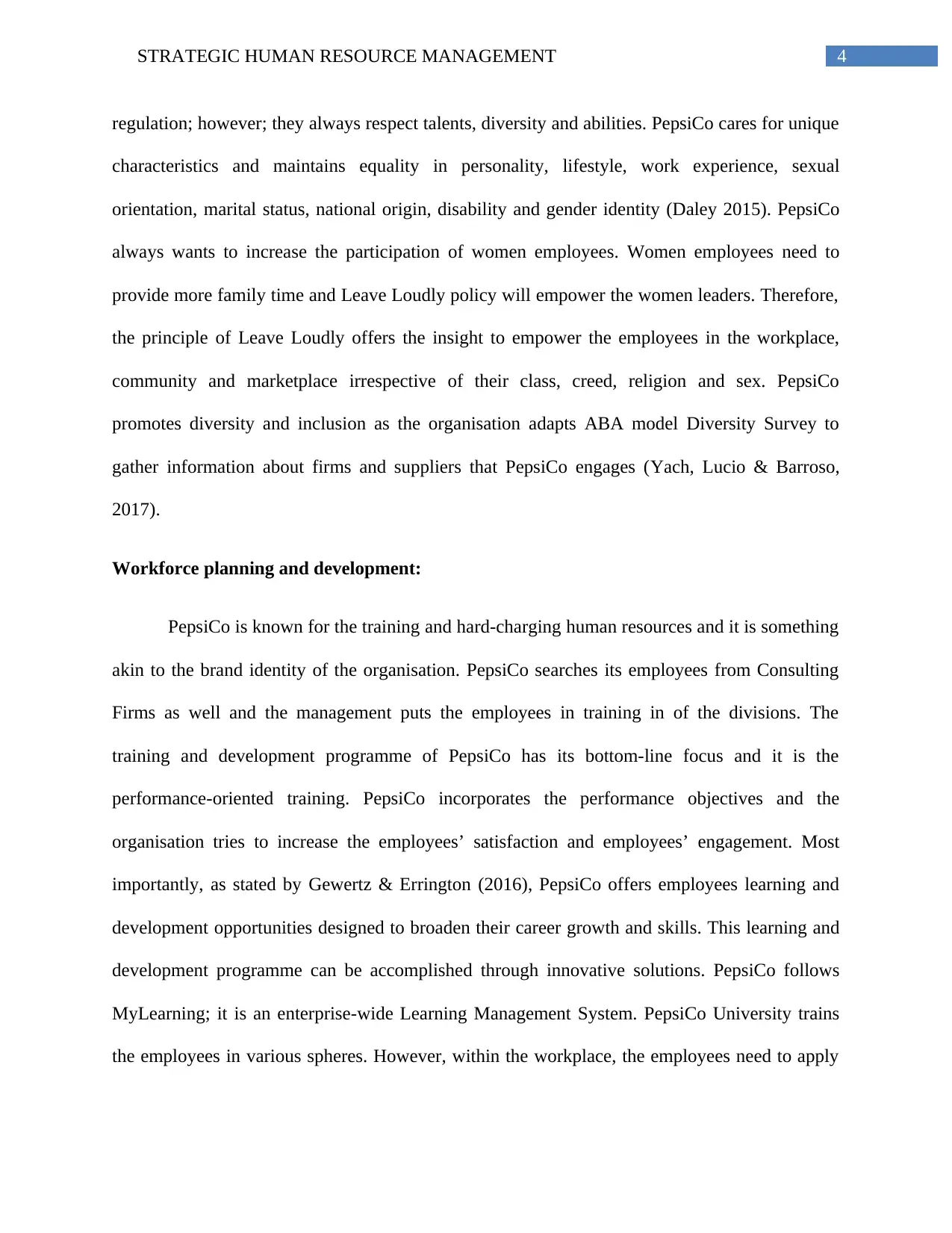
4STRATEGIC HUMAN RESOURCE MANAGEMENT
regulation; however; they always respect talents, diversity and abilities. PepsiCo cares for unique
characteristics and maintains equality in personality, lifestyle, work experience, sexual
orientation, marital status, national origin, disability and gender identity (Daley 2015). PepsiCo
always wants to increase the participation of women employees. Women employees need to
provide more family time and Leave Loudly policy will empower the women leaders. Therefore,
the principle of Leave Loudly offers the insight to empower the employees in the workplace,
community and marketplace irrespective of their class, creed, religion and sex. PepsiCo
promotes diversity and inclusion as the organisation adapts ABA model Diversity Survey to
gather information about firms and suppliers that PepsiCo engages (Yach, Lucio & Barroso,
2017).
Workforce planning and development:
PepsiCo is known for the training and hard-charging human resources and it is something
akin to the brand identity of the organisation. PepsiCo searches its employees from Consulting
Firms as well and the management puts the employees in training in of the divisions. The
training and development programme of PepsiCo has its bottom-line focus and it is the
performance-oriented training. PepsiCo incorporates the performance objectives and the
organisation tries to increase the employees’ satisfaction and employees’ engagement. Most
importantly, as stated by Gewertz & Errington (2016), PepsiCo offers employees learning and
development opportunities designed to broaden their career growth and skills. This learning and
development programme can be accomplished through innovative solutions. PepsiCo follows
MyLearning; it is an enterprise-wide Learning Management System. PepsiCo University trains
the employees in various spheres. However, within the workplace, the employees need to apply
regulation; however; they always respect talents, diversity and abilities. PepsiCo cares for unique
characteristics and maintains equality in personality, lifestyle, work experience, sexual
orientation, marital status, national origin, disability and gender identity (Daley 2015). PepsiCo
always wants to increase the participation of women employees. Women employees need to
provide more family time and Leave Loudly policy will empower the women leaders. Therefore,
the principle of Leave Loudly offers the insight to empower the employees in the workplace,
community and marketplace irrespective of their class, creed, religion and sex. PepsiCo
promotes diversity and inclusion as the organisation adapts ABA model Diversity Survey to
gather information about firms and suppliers that PepsiCo engages (Yach, Lucio & Barroso,
2017).
Workforce planning and development:
PepsiCo is known for the training and hard-charging human resources and it is something
akin to the brand identity of the organisation. PepsiCo searches its employees from Consulting
Firms as well and the management puts the employees in training in of the divisions. The
training and development programme of PepsiCo has its bottom-line focus and it is the
performance-oriented training. PepsiCo incorporates the performance objectives and the
organisation tries to increase the employees’ satisfaction and employees’ engagement. Most
importantly, as stated by Gewertz & Errington (2016), PepsiCo offers employees learning and
development opportunities designed to broaden their career growth and skills. This learning and
development programme can be accomplished through innovative solutions. PepsiCo follows
MyLearning; it is an enterprise-wide Learning Management System. PepsiCo University trains
the employees in various spheres. However, within the workplace, the employees need to apply
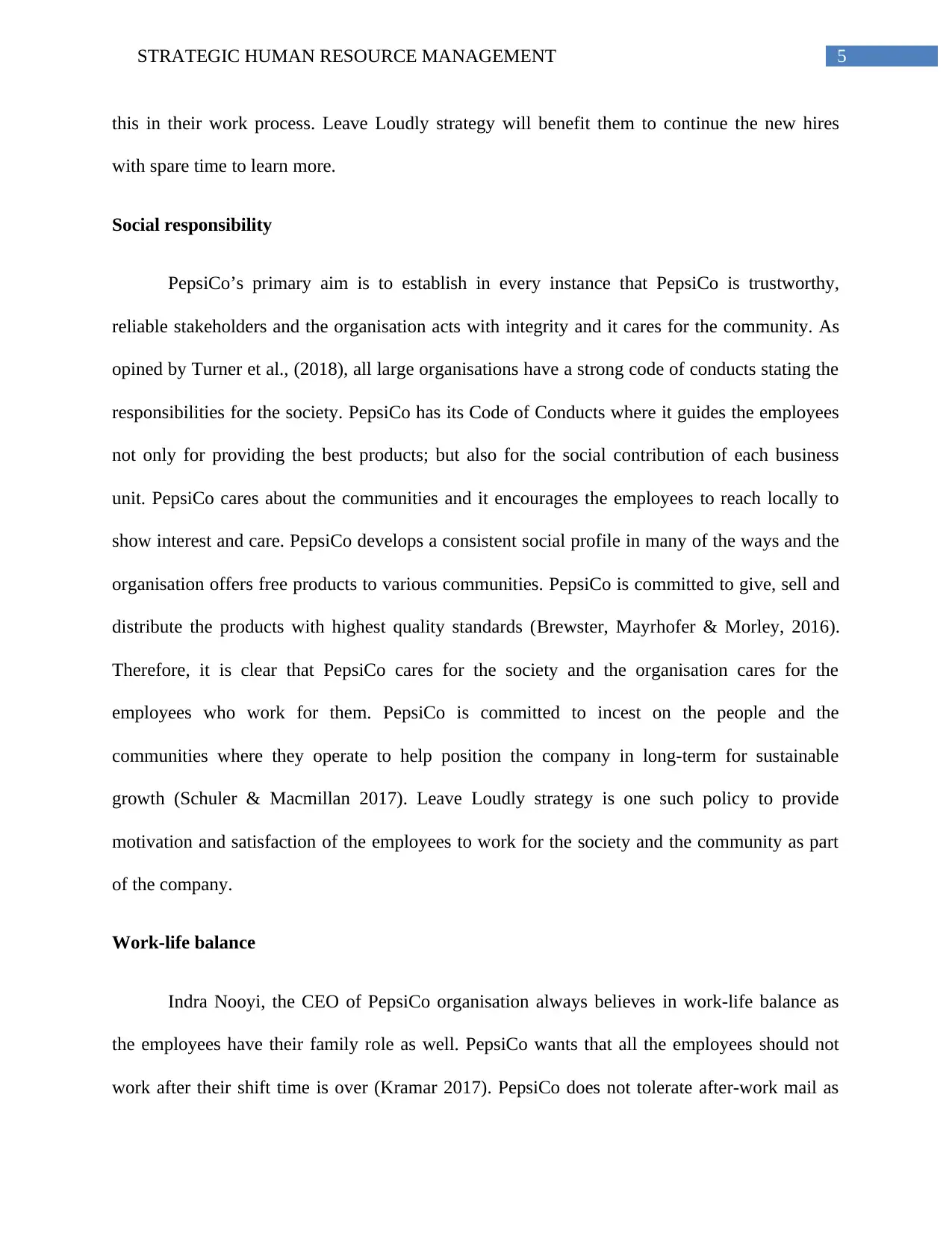
5STRATEGIC HUMAN RESOURCE MANAGEMENT
this in their work process. Leave Loudly strategy will benefit them to continue the new hires
with spare time to learn more.
Social responsibility
PepsiCo’s primary aim is to establish in every instance that PepsiCo is trustworthy,
reliable stakeholders and the organisation acts with integrity and it cares for the community. As
opined by Turner et al., (2018), all large organisations have a strong code of conducts stating the
responsibilities for the society. PepsiCo has its Code of Conducts where it guides the employees
not only for providing the best products; but also for the social contribution of each business
unit. PepsiCo cares about the communities and it encourages the employees to reach locally to
show interest and care. PepsiCo develops a consistent social profile in many of the ways and the
organisation offers free products to various communities. PepsiCo is committed to give, sell and
distribute the products with highest quality standards (Brewster, Mayrhofer & Morley, 2016).
Therefore, it is clear that PepsiCo cares for the society and the organisation cares for the
employees who work for them. PepsiCo is committed to incest on the people and the
communities where they operate to help position the company in long-term for sustainable
growth (Schuler & Macmillan 2017). Leave Loudly strategy is one such policy to provide
motivation and satisfaction of the employees to work for the society and the community as part
of the company.
Work-life balance
Indra Nooyi, the CEO of PepsiCo organisation always believes in work-life balance as
the employees have their family role as well. PepsiCo wants that all the employees should not
work after their shift time is over (Kramar 2017). PepsiCo does not tolerate after-work mail as
this in their work process. Leave Loudly strategy will benefit them to continue the new hires
with spare time to learn more.
Social responsibility
PepsiCo’s primary aim is to establish in every instance that PepsiCo is trustworthy,
reliable stakeholders and the organisation acts with integrity and it cares for the community. As
opined by Turner et al., (2018), all large organisations have a strong code of conducts stating the
responsibilities for the society. PepsiCo has its Code of Conducts where it guides the employees
not only for providing the best products; but also for the social contribution of each business
unit. PepsiCo cares about the communities and it encourages the employees to reach locally to
show interest and care. PepsiCo develops a consistent social profile in many of the ways and the
organisation offers free products to various communities. PepsiCo is committed to give, sell and
distribute the products with highest quality standards (Brewster, Mayrhofer & Morley, 2016).
Therefore, it is clear that PepsiCo cares for the society and the organisation cares for the
employees who work for them. PepsiCo is committed to incest on the people and the
communities where they operate to help position the company in long-term for sustainable
growth (Schuler & Macmillan 2017). Leave Loudly strategy is one such policy to provide
motivation and satisfaction of the employees to work for the society and the community as part
of the company.
Work-life balance
Indra Nooyi, the CEO of PepsiCo organisation always believes in work-life balance as
the employees have their family role as well. PepsiCo wants that all the employees should not
work after their shift time is over (Kramar 2017). PepsiCo does not tolerate after-work mail as
⊘ This is a preview!⊘
Do you want full access?
Subscribe today to unlock all pages.

Trusted by 1+ million students worldwide
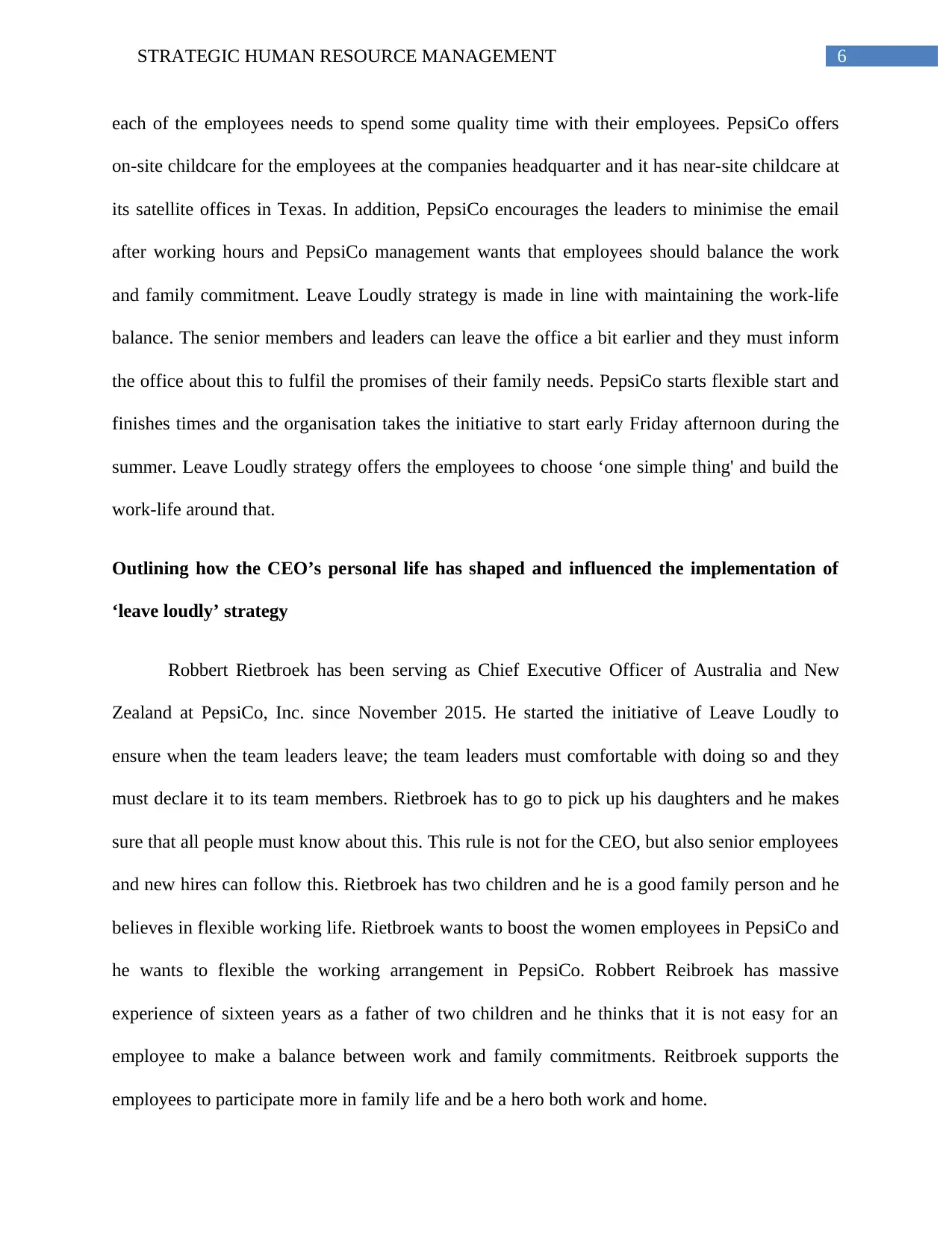
6STRATEGIC HUMAN RESOURCE MANAGEMENT
each of the employees needs to spend some quality time with their employees. PepsiCo offers
on-site childcare for the employees at the companies headquarter and it has near-site childcare at
its satellite offices in Texas. In addition, PepsiCo encourages the leaders to minimise the email
after working hours and PepsiCo management wants that employees should balance the work
and family commitment. Leave Loudly strategy is made in line with maintaining the work-life
balance. The senior members and leaders can leave the office a bit earlier and they must inform
the office about this to fulfil the promises of their family needs. PepsiCo starts flexible start and
finishes times and the organisation takes the initiative to start early Friday afternoon during the
summer. Leave Loudly strategy offers the employees to choose ‘one simple thing' and build the
work-life around that.
Outlining how the CEO’s personal life has shaped and influenced the implementation of
‘leave loudly’ strategy
Robbert Rietbroek has been serving as Chief Executive Officer of Australia and New
Zealand at PepsiCo, Inc. since November 2015. He started the initiative of Leave Loudly to
ensure when the team leaders leave; the team leaders must comfortable with doing so and they
must declare it to its team members. Rietbroek has to go to pick up his daughters and he makes
sure that all people must know about this. This rule is not for the CEO, but also senior employees
and new hires can follow this. Rietbroek has two children and he is a good family person and he
believes in flexible working life. Rietbroek wants to boost the women employees in PepsiCo and
he wants to flexible the working arrangement in PepsiCo. Robbert Reibroek has massive
experience of sixteen years as a father of two children and he thinks that it is not easy for an
employee to make a balance between work and family commitments. Reitbroek supports the
employees to participate more in family life and be a hero both work and home.
each of the employees needs to spend some quality time with their employees. PepsiCo offers
on-site childcare for the employees at the companies headquarter and it has near-site childcare at
its satellite offices in Texas. In addition, PepsiCo encourages the leaders to minimise the email
after working hours and PepsiCo management wants that employees should balance the work
and family commitment. Leave Loudly strategy is made in line with maintaining the work-life
balance. The senior members and leaders can leave the office a bit earlier and they must inform
the office about this to fulfil the promises of their family needs. PepsiCo starts flexible start and
finishes times and the organisation takes the initiative to start early Friday afternoon during the
summer. Leave Loudly strategy offers the employees to choose ‘one simple thing' and build the
work-life around that.
Outlining how the CEO’s personal life has shaped and influenced the implementation of
‘leave loudly’ strategy
Robbert Rietbroek has been serving as Chief Executive Officer of Australia and New
Zealand at PepsiCo, Inc. since November 2015. He started the initiative of Leave Loudly to
ensure when the team leaders leave; the team leaders must comfortable with doing so and they
must declare it to its team members. Rietbroek has to go to pick up his daughters and he makes
sure that all people must know about this. This rule is not for the CEO, but also senior employees
and new hires can follow this. Rietbroek has two children and he is a good family person and he
believes in flexible working life. Rietbroek wants to boost the women employees in PepsiCo and
he wants to flexible the working arrangement in PepsiCo. Robbert Reibroek has massive
experience of sixteen years as a father of two children and he thinks that it is not easy for an
employee to make a balance between work and family commitments. Reitbroek supports the
employees to participate more in family life and be a hero both work and home.
Paraphrase This Document
Need a fresh take? Get an instant paraphrase of this document with our AI Paraphraser
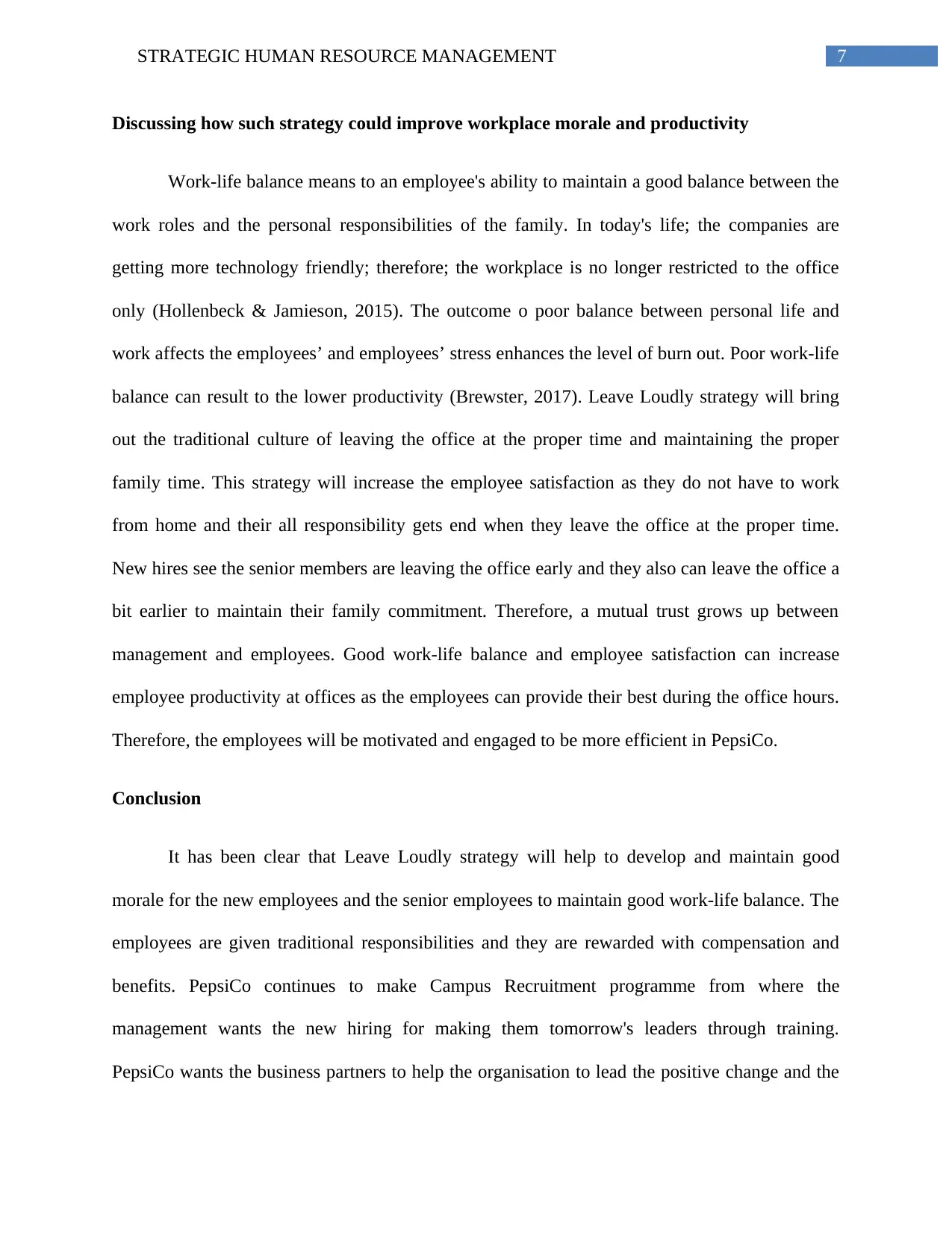
7STRATEGIC HUMAN RESOURCE MANAGEMENT
Discussing how such strategy could improve workplace morale and productivity
Work-life balance means to an employee's ability to maintain a good balance between the
work roles and the personal responsibilities of the family. In today's life; the companies are
getting more technology friendly; therefore; the workplace is no longer restricted to the office
only (Hollenbeck & Jamieson, 2015). The outcome o poor balance between personal life and
work affects the employees’ and employees’ stress enhances the level of burn out. Poor work-life
balance can result to the lower productivity (Brewster, 2017). Leave Loudly strategy will bring
out the traditional culture of leaving the office at the proper time and maintaining the proper
family time. This strategy will increase the employee satisfaction as they do not have to work
from home and their all responsibility gets end when they leave the office at the proper time.
New hires see the senior members are leaving the office early and they also can leave the office a
bit earlier to maintain their family commitment. Therefore, a mutual trust grows up between
management and employees. Good work-life balance and employee satisfaction can increase
employee productivity at offices as the employees can provide their best during the office hours.
Therefore, the employees will be motivated and engaged to be more efficient in PepsiCo.
Conclusion
It has been clear that Leave Loudly strategy will help to develop and maintain good
morale for the new employees and the senior employees to maintain good work-life balance. The
employees are given traditional responsibilities and they are rewarded with compensation and
benefits. PepsiCo continues to make Campus Recruitment programme from where the
management wants the new hiring for making them tomorrow's leaders through training.
PepsiCo wants the business partners to help the organisation to lead the positive change and the
Discussing how such strategy could improve workplace morale and productivity
Work-life balance means to an employee's ability to maintain a good balance between the
work roles and the personal responsibilities of the family. In today's life; the companies are
getting more technology friendly; therefore; the workplace is no longer restricted to the office
only (Hollenbeck & Jamieson, 2015). The outcome o poor balance between personal life and
work affects the employees’ and employees’ stress enhances the level of burn out. Poor work-life
balance can result to the lower productivity (Brewster, 2017). Leave Loudly strategy will bring
out the traditional culture of leaving the office at the proper time and maintaining the proper
family time. This strategy will increase the employee satisfaction as they do not have to work
from home and their all responsibility gets end when they leave the office at the proper time.
New hires see the senior members are leaving the office early and they also can leave the office a
bit earlier to maintain their family commitment. Therefore, a mutual trust grows up between
management and employees. Good work-life balance and employee satisfaction can increase
employee productivity at offices as the employees can provide their best during the office hours.
Therefore, the employees will be motivated and engaged to be more efficient in PepsiCo.
Conclusion
It has been clear that Leave Loudly strategy will help to develop and maintain good
morale for the new employees and the senior employees to maintain good work-life balance. The
employees are given traditional responsibilities and they are rewarded with compensation and
benefits. PepsiCo continues to make Campus Recruitment programme from where the
management wants the new hiring for making them tomorrow's leaders through training.
PepsiCo wants the business partners to help the organisation to lead the positive change and the
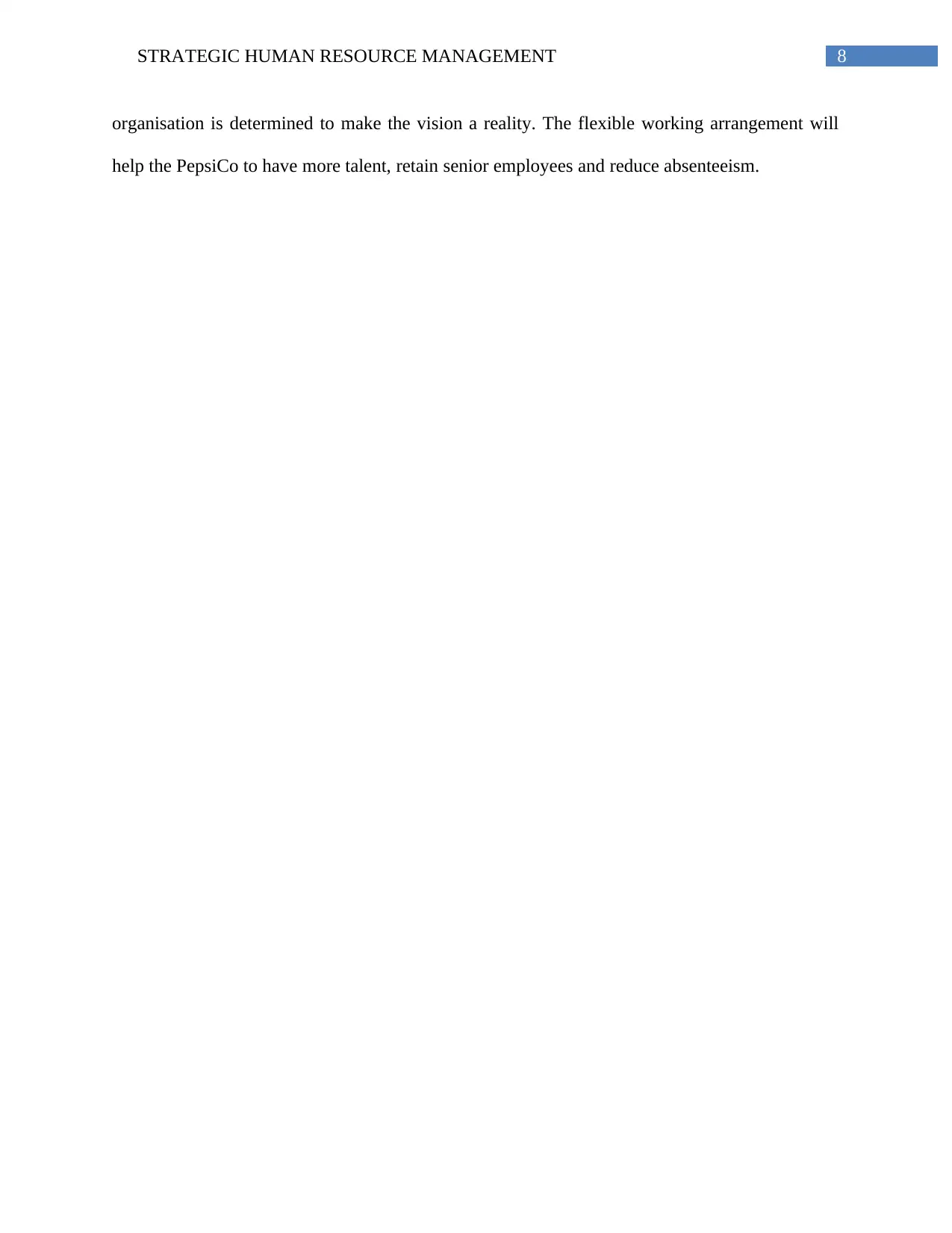
8STRATEGIC HUMAN RESOURCE MANAGEMENT
organisation is determined to make the vision a reality. The flexible working arrangement will
help the PepsiCo to have more talent, retain senior employees and reduce absenteeism.
organisation is determined to make the vision a reality. The flexible working arrangement will
help the PepsiCo to have more talent, retain senior employees and reduce absenteeism.
⊘ This is a preview!⊘
Do you want full access?
Subscribe today to unlock all pages.

Trusted by 1+ million students worldwide
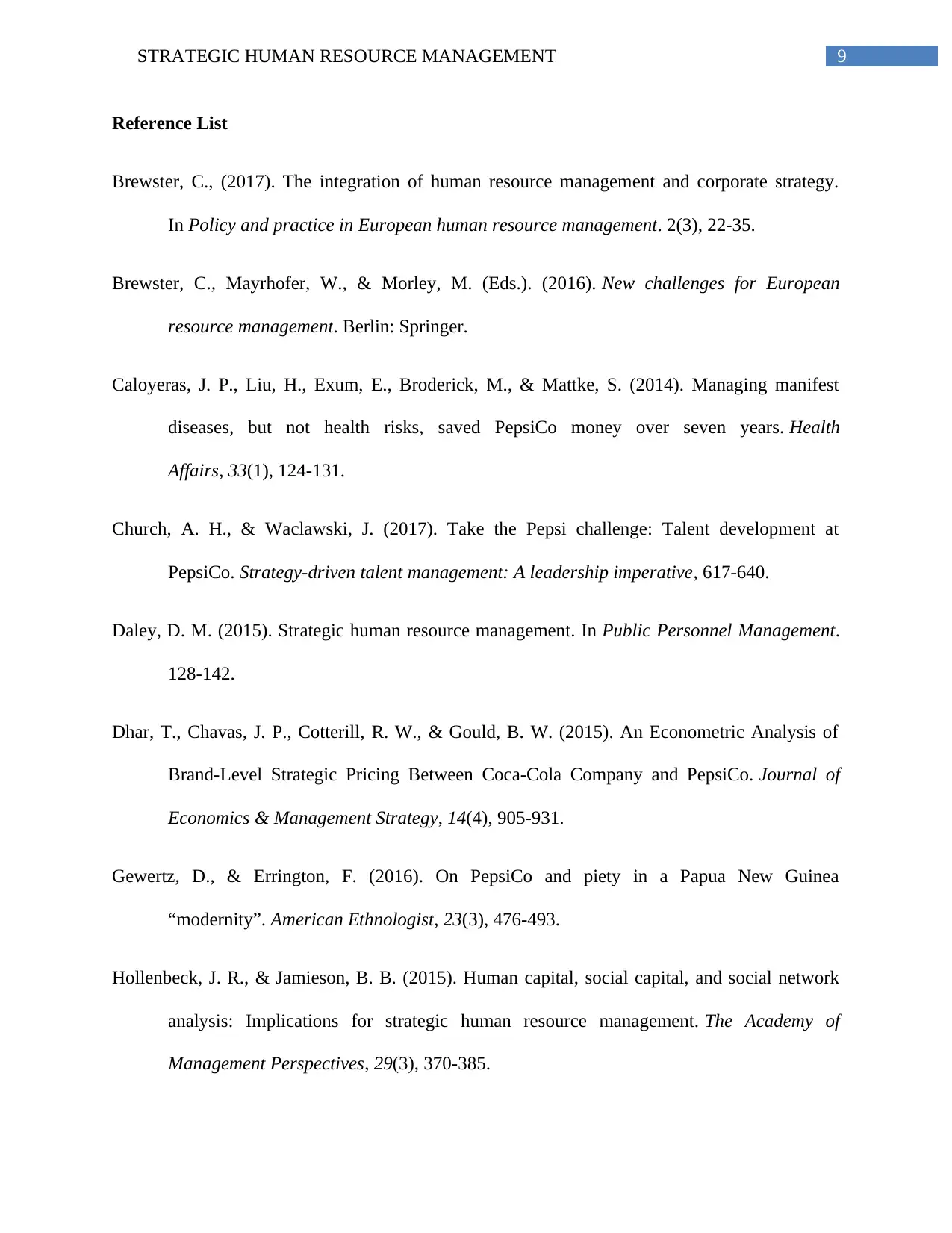
9STRATEGIC HUMAN RESOURCE MANAGEMENT
Reference List
Brewster, C., (2017). The integration of human resource management and corporate strategy.
In Policy and practice in European human resource management. 2(3), 22-35.
Brewster, C., Mayrhofer, W., & Morley, M. (Eds.). (2016). New challenges for European
resource management. Berlin: Springer.
Caloyeras, J. P., Liu, H., Exum, E., Broderick, M., & Mattke, S. (2014). Managing manifest
diseases, but not health risks, saved PepsiCo money over seven years. Health
Affairs, 33(1), 124-131.
Church, A. H., & Waclawski, J. (2017). Take the Pepsi challenge: Talent development at
PepsiCo. Strategy-driven talent management: A leadership imperative, 617-640.
Daley, D. M. (2015). Strategic human resource management. In Public Personnel Management.
128-142.
Dhar, T., Chavas, J. P., Cotterill, R. W., & Gould, B. W. (2015). An Econometric Analysis of
Brand‐Level Strategic Pricing Between Coca‐Cola Company and PepsiCo. Journal of
Economics & Management Strategy, 14(4), 905-931.
Gewertz, D., & Errington, F. (2016). On PepsiCo and piety in a Papua New Guinea
“modernity”. American Ethnologist, 23(3), 476-493.
Hollenbeck, J. R., & Jamieson, B. B. (2015). Human capital, social capital, and social network
analysis: Implications for strategic human resource management. The Academy of
Management Perspectives, 29(3), 370-385.
Reference List
Brewster, C., (2017). The integration of human resource management and corporate strategy.
In Policy and practice in European human resource management. 2(3), 22-35.
Brewster, C., Mayrhofer, W., & Morley, M. (Eds.). (2016). New challenges for European
resource management. Berlin: Springer.
Caloyeras, J. P., Liu, H., Exum, E., Broderick, M., & Mattke, S. (2014). Managing manifest
diseases, but not health risks, saved PepsiCo money over seven years. Health
Affairs, 33(1), 124-131.
Church, A. H., & Waclawski, J. (2017). Take the Pepsi challenge: Talent development at
PepsiCo. Strategy-driven talent management: A leadership imperative, 617-640.
Daley, D. M. (2015). Strategic human resource management. In Public Personnel Management.
128-142.
Dhar, T., Chavas, J. P., Cotterill, R. W., & Gould, B. W. (2015). An Econometric Analysis of
Brand‐Level Strategic Pricing Between Coca‐Cola Company and PepsiCo. Journal of
Economics & Management Strategy, 14(4), 905-931.
Gewertz, D., & Errington, F. (2016). On PepsiCo and piety in a Papua New Guinea
“modernity”. American Ethnologist, 23(3), 476-493.
Hollenbeck, J. R., & Jamieson, B. B. (2015). Human capital, social capital, and social network
analysis: Implications for strategic human resource management. The Academy of
Management Perspectives, 29(3), 370-385.
Paraphrase This Document
Need a fresh take? Get an instant paraphrase of this document with our AI Paraphraser
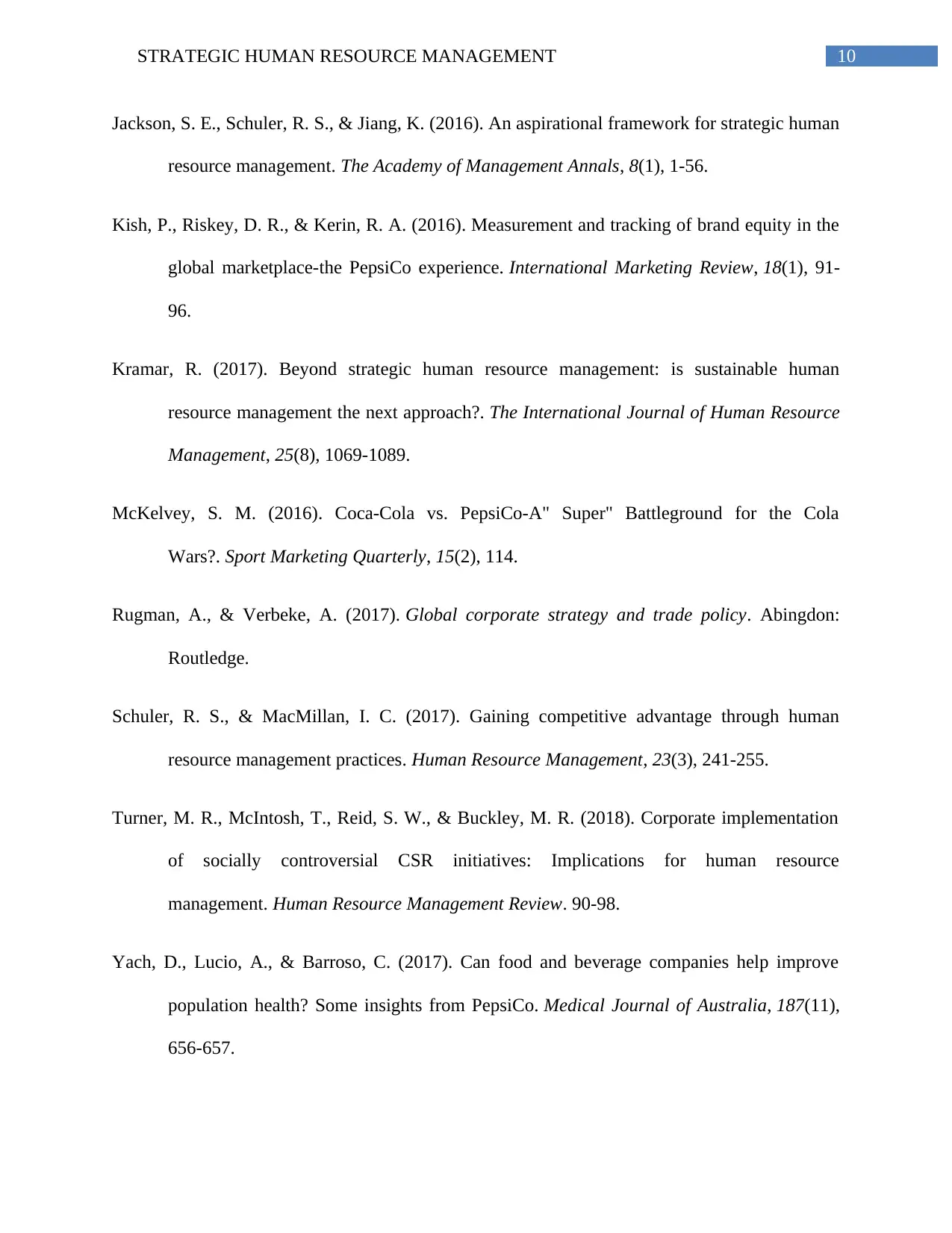
10STRATEGIC HUMAN RESOURCE MANAGEMENT
Jackson, S. E., Schuler, R. S., & Jiang, K. (2016). An aspirational framework for strategic human
resource management. The Academy of Management Annals, 8(1), 1-56.
Kish, P., Riskey, D. R., & Kerin, R. A. (2016). Measurement and tracking of brand equity in the
global marketplace-the PepsiCo experience. International Marketing Review, 18(1), 91-
96.
Kramar, R. (2017). Beyond strategic human resource management: is sustainable human
resource management the next approach?. The International Journal of Human Resource
Management, 25(8), 1069-1089.
McKelvey, S. M. (2016). Coca-Cola vs. PepsiCo-A" Super" Battleground for the Cola
Wars?. Sport Marketing Quarterly, 15(2), 114.
Rugman, A., & Verbeke, A. (2017). Global corporate strategy and trade policy. Abingdon:
Routledge.
Schuler, R. S., & MacMillan, I. C. (2017). Gaining competitive advantage through human
resource management practices. Human Resource Management, 23(3), 241-255.
Turner, M. R., McIntosh, T., Reid, S. W., & Buckley, M. R. (2018). Corporate implementation
of socially controversial CSR initiatives: Implications for human resource
management. Human Resource Management Review. 90-98.
Yach, D., Lucio, A., & Barroso, C. (2017). Can food and beverage companies help improve
population health? Some insights from PepsiCo. Medical Journal of Australia, 187(11),
656-657.
Jackson, S. E., Schuler, R. S., & Jiang, K. (2016). An aspirational framework for strategic human
resource management. The Academy of Management Annals, 8(1), 1-56.
Kish, P., Riskey, D. R., & Kerin, R. A. (2016). Measurement and tracking of brand equity in the
global marketplace-the PepsiCo experience. International Marketing Review, 18(1), 91-
96.
Kramar, R. (2017). Beyond strategic human resource management: is sustainable human
resource management the next approach?. The International Journal of Human Resource
Management, 25(8), 1069-1089.
McKelvey, S. M. (2016). Coca-Cola vs. PepsiCo-A" Super" Battleground for the Cola
Wars?. Sport Marketing Quarterly, 15(2), 114.
Rugman, A., & Verbeke, A. (2017). Global corporate strategy and trade policy. Abingdon:
Routledge.
Schuler, R. S., & MacMillan, I. C. (2017). Gaining competitive advantage through human
resource management practices. Human Resource Management, 23(3), 241-255.
Turner, M. R., McIntosh, T., Reid, S. W., & Buckley, M. R. (2018). Corporate implementation
of socially controversial CSR initiatives: Implications for human resource
management. Human Resource Management Review. 90-98.
Yach, D., Lucio, A., & Barroso, C. (2017). Can food and beverage companies help improve
population health? Some insights from PepsiCo. Medical Journal of Australia, 187(11),
656-657.
1 out of 11
Related Documents
Your All-in-One AI-Powered Toolkit for Academic Success.
+13062052269
info@desklib.com
Available 24*7 on WhatsApp / Email
![[object Object]](/_next/static/media/star-bottom.7253800d.svg)
Unlock your academic potential
Copyright © 2020–2025 A2Z Services. All Rights Reserved. Developed and managed by ZUCOL.




